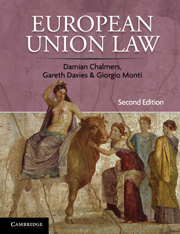Book contents
- Frontmatter
- Contents
- Map
- Preface
- Abbreviations
- Table of Cases
- Table of Treaties, Instruments and Legislation
- Table of Equivalents
- Electronic Working Paper Series
- 1 European Integration and the Treaty on European Union
- 2 The EU Institutions
- 3 Union Law-making
- 4 The EU Judicial Order
- 5 The Authority of EU Law
- 6 Fundamental Rights
- 7 Rights and Remedies in National Courts
- 8 Infringement Proceedings
- 9 Governance
- 10 Judicial Review
- 11 EU citizenship
- 12 EU Law and Non-EU Nationals
- 13 Equal Opportunities Law and Policy
- 14 EU Criminal Law
- 15 External Relations
- 16 The Internal Market
- 17 Economic and Monetary Union
- 18 The Free Movement of Goods
- 19 The Free Movement of Services
- 20 The Pursuit of an Occupation in Another Member State
- 21 Trade Restrictions and Public Goods
- 22 EU Competition Law: Function and Enforcement
- 23 Antitrust and Monopolies
- 24 State Regulation and EU Competition Law
- Index
22 - EU Competition Law: Function and Enforcement
- Frontmatter
- Contents
- Map
- Preface
- Abbreviations
- Table of Cases
- Table of Treaties, Instruments and Legislation
- Table of Equivalents
- Electronic Working Paper Series
- 1 European Integration and the Treaty on European Union
- 2 The EU Institutions
- 3 Union Law-making
- 4 The EU Judicial Order
- 5 The Authority of EU Law
- 6 Fundamental Rights
- 7 Rights and Remedies in National Courts
- 8 Infringement Proceedings
- 9 Governance
- 10 Judicial Review
- 11 EU citizenship
- 12 EU Law and Non-EU Nationals
- 13 Equal Opportunities Law and Policy
- 14 EU Criminal Law
- 15 External Relations
- 16 The Internal Market
- 17 Economic and Monetary Union
- 18 The Free Movement of Goods
- 19 The Free Movement of Services
- 20 The Pursuit of an Occupation in Another Member State
- 21 Trade Restrictions and Public Goods
- 22 EU Competition Law: Function and Enforcement
- 23 Antitrust and Monopolies
- 24 State Regulation and EU Competition Law
- Index
Summary
INTRODUCTION
This section of the book contains a survey of the main competition law provisions, whose principal task is to regulate the behaviour of firms in the market. For example, competition law forbids price fixing cartels among competitors and other agreements that restrict competition (Article 101 TFEU (ex Article 81 EC)) and prohibits monopolies from charging excessive prices (Article 102 TFEU (ex Article 82 EC)). Firms that infringe these rules may be fined by the Commission, indicating that competition law is designed principally to deter anti-competitive conduct. These two Treaty provisions are discussed in Chapter 23. Competition law also monitors Member States' regulation of markets and can prohibit anti-competitive legislation as well as promote competition in markets where national law has prevented competition. Here, law is enforced not merely to deter anti-competitive action, but also to open markets to competition. This function is analysed in Chapter 24. Finally, competition law monitors mergers to prevent those that restrict competition when it is feared that the merger gives the newly formed entity too much power. This is discussed in Chapter 25, which is available as a supplement online.
When the EEC Treaty was negotiated, there was considerable pressure from Americans, but also by segments of Europe's academic community, that competition law should be included in the Treaty.
- Type
- Chapter
- Information
- European Union LawCases and Materials, pp. 908 - 961Publisher: Cambridge University PressPrint publication year: 2010

